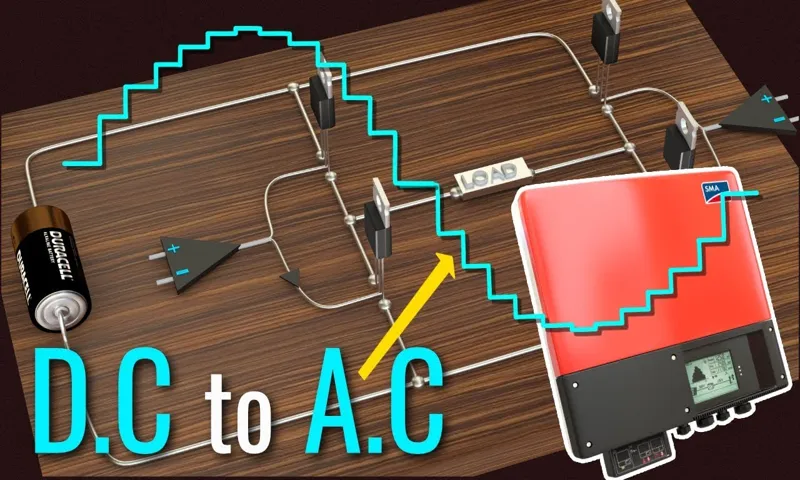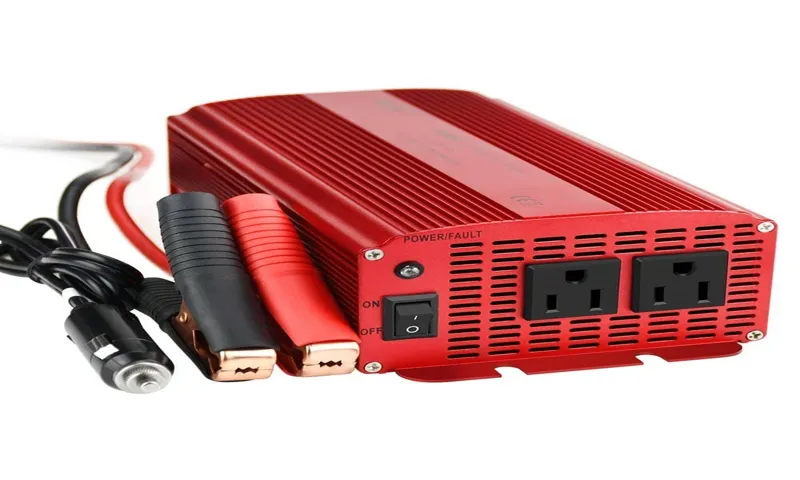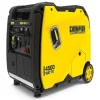Looking for a reliable source of power while on the go? Power inverters might just be what you need! In today’s modern world, where technology plays a vital role in our daily lives, having a portable and efficient power supply is crucial. Whether you’re camping in the great outdoors or need to charge your devices during a long road trip, power inverters can save the day. But what exactly are power inverters, and how do they work? In this blog post, we will explore the ins and outs of power inverters, understand their capabilities, and discover how they can make your life easier.
So, buckle up and get ready to explore the world of power inverters!
Table of Contents
What is a Power Inverter?
Have you ever wondered how power inverters work? Well, let me break it down for you. A power inverter is a device that converts DC (direct current) power into AC (alternating current) power. In simpler terms, it takes the power from a battery or a DC power source and transforms it into the type of power that can be used by most electronic devices and appliances.
Think of it as a translator that allows your electronics to understand and use the power from your car battery or solar panel. Without a power inverter, you wouldn’t be able to charge your phone or use your laptop while on a camping trip or during a power outage. So, the next time you plug in your device and it starts charging, you can thank the power inverter for making it all happen.
Definition and Functionality
power inverter. A power inverter is a device that converts direct current (DC) power from a battery into alternating current (AC) power that can be used to power household appliances and electronic devices. It essentially takes the low-voltage power that is stored in a battery or another DC power source and increases it to the higher voltage levels needed to run AC-powered devices.
Think of a power inverter as a translator that bridges the gap between the DC world and the AC world. It allows you to use your battery power or other DC power sources to power things like laptops, smartphones, refrigerators, and even power tools. The functionality of a power inverter is quite straightforward.
You simply connect it to your DC power source, such as a car battery or a solar panel, and then plug your AC-powered devices into the inverter. The inverter then converts the DC power into AC power, which flows through the outlets on the device. Power inverters come in a variety of sizes and power capacities, so it’s important to choose the right one for your needs.
Some inverters are small and portable, making them ideal for powering devices on the go, while others are larger and more powerful, suitable for running multiple appliances or even whole-house backup power. In conclusion, a power inverter is a handy device that allows you to use DC power sources to power AC-powered devices. Whether you’re camping, traveling, or experiencing a power outage, a power inverter can be a lifesaver.
So the next time you need to power your electronics without access to traditional AC power, consider adding a power inverter to your toolkit.

Types of Power Inverters
power inverters, types of power inverters
How Do Power Inverters Work?
Power inverters are devices that convert direct current (DC) electricity into alternating current (AC) electricity, allowing you to power AC devices using a DC power source, such as a car battery or solar panel. They are commonly used when you need to power electronic devices or appliances while you’re on the go, such as when camping or traveling in an RV. But how exactly do power inverters work? At their core, power inverters utilize electronic components to convert the DC input into AC output.
The process starts with a converter circuit that converts the DC input into a high-frequency AC signal. This AC signal is then fed into a transformer, which increases or decreases the voltage according to the desired output. The transformed AC signal is then filtered and modified to produce the desired AC waveform, whether it be a pure sine wave, modified sine wave, or square wave.
One analogy to understand the working of a power inverter is to think of it as a translator. Just like a translator converts one language into another, a power inverter translates the electrical language from DC to AC. The DC power source speaks in a different electrical “language” than the AC devices you want to power, and the power inverter acts as the middleman, converting that language so the two can communicate effectively.
Power inverters come in various sizes and capacities, with different types and features to suit different needs. Some inverters offer a pure sine wave output, which is the cleanest and most reliable type of AC power. Others provide modified sine wave or square wave outputs, which may be more suitable for certain appliances or devices.
It’s important to choose the right type of power inverter for your specific needs to ensure compatibility and avoid any potential damage to your devices. In conclusion, power inverters are essential devices that allow you to use AC devices with a DC power source. Through a process of conversion, filtration, and modification, they translate the language of DC electricity into the language of AC electricity.
So whether you’re on the road or off the grid, power inverters make it possible to power your favorite electronic devices and appliances.
Overview of the Conversion Process
power inverters, conversion process, how power inverters work, electrical power, direct current (DC) to alternating current (AC), voltage, frequency, electricity, appliances, solar cells, battery banks, motorhomes, boats Power inverters are essential devices that allow us to convert electrical power from one form to another. In particular, they are used to convert direct current (DC) to alternating current (AC), allowing us to power appliances that require AC electricity. But how do power inverters work? Well, it all starts with understanding the conversion process.
When it comes to electricity, there are two main types: direct current (DC) and alternating current (AC). DC electricity flows in one direction, while AC electricity constantly changes direction. Most of the electrical devices we use, such as household appliances, operate on AC power.
Power inverters play a crucial role in scenarios where only DC power is available, such as in solar cells or battery banks. They allow us to convert the DC power into AC power, making it compatible with our regular appliances. This is especially useful in situations where we need power on the go, such as in motorhomes or boats.
The conversion process involves several steps. First, the DC power is delivered to the power inverter. The inverter then converts the DC voltage to AC voltage, typically at 120 or 240 volts.
It also adjusts the frequency of the AC electricity to match the standard frequency used in the area where it will be used. Once the power has been converted from DC to AC, it can be used to power various appliances and devices. The inverter ensures that the AC power generated is stable and safe for use.
It also protects against abrupt changes in voltage or frequency that could damage electrical equipment. In summary, power inverters are crucial devices that allow us to convert DC power into AC power. They play a vital role in enabling us to power appliances that require AC electricity, even in situations where only DC power is available.
Step 1: Converting DC to AC
power inverters, converting DC to AC, how power inverters work, DC power, AC power, electrical power, direct current, alternating current, sine wave, electronic devices, battery power, car battery, electrical outlets
Step 2: Voltage Regulation
power inverters In step 2 of the power inverter process, voltage regulation takes place. This is where the power inverter ensures that the voltage output is consistent and matches the requirements of the device it is powering. Think of it like a traffic cop directing the flow of cars.
The power inverter acts as the traffic cop, making sure the voltage is regulated and controlled so that it doesn’t cause any damage to the device. Just like different cars require different speeds to function properly, different devices require different voltages. The power inverter adjusts the voltage accordingly, almost like a chameleon changing its color to blend in with its environment.
So, whether you’re powering a laptop, a phone charger, or even an appliance, the power inverter’s voltage regulation is what ensures smooth and safe operation. So the next time you use your power inverter, remember that it’s working hard behind the scenes to keep the voltage in check and protect your devices.
Step 3: Output Waveform
power inverters
Applications and Uses of Power Inverters
Do you ever wonder how power inverters work? Well, let me break it down for you! Power inverters are incredible devices that take DC power and convert it into AC power, allowing you to use your electronic devices and appliances even when you’re on the go. They have a complex internal circuitry that transforms the voltage and changes the type of current. The input DC power is fed into an inverter circuit, where it gets transformed into a high-frequency AC power.
This AC power is then sent through a transformer, which increases the voltage level to the desired level. Finally, the output AC power is filtered and regulated to ensure a stable and clean power supply for your devices. So, whether you’re camping, traveling, or experiencing a power outage, a power inverter is your ultimate savior!
Powering Electronics in Vehicles
power inverters
Emergency Backup Power
power inverters, emergency backup power
Renewable Energy Systems
power inverters, applications and uses, renewable energy systems
Choosing a Power Inverter
Have you ever wondered how power inverters work? Power inverters are devices that convert DC (direct current) electricity into AC (alternating current) electricity. They are commonly used to power household appliances, electronics, and even vehicles, when connected to a battery or other DC power source. The process is quite fascinating.
When DC electricity is passed through an inverter, it is converted into AC electricity through a series of electronic components. These components include transistors, capacitors, and transformers. The transistors act as switches, rapidly turning the DC voltage on and off, which creates a waveform that closely resembles the AC waveform.
The capacitors smooth out any inconsistencies in the voltage, ensuring a steady flow of power. Finally, the transformers further adjust the voltage to the desired level. This process allows you to use AC appliances and devices even when you only have access to DC power.
So, the next time you’re camping or experiencing a power outage, you’ll know how those handy power inverters are able to keep your electronics running.
Determining Power Requirements
power inverter, power requirements
Considering Waveform Type
power inverter, waveform type
Safety and Protection Features
power inverter, safety features, protection features
Conclusion
In conclusion, power inverters are like the magical translators of the electrical world. They possess the uncanny ability to convert the language of direct current into the tongue of alternating current, ensuring that our electronic devices can communicate and function harmoniously. It’s as if they possess an enchanting spell that allows electrons to dance between the positive and negative terminals, creating a symphony of power that flows seamlessly through our everyday lives.
So next time you plug in your laptop or charge your phone, take a moment to appreciate the mystifying magic of power inverters, silently working their sorcery behind the scenes to bring electricity into our modern world.”
FAQs
How do power inverters work?
Power inverters work by converting direct current (DC) electricity from a battery or solar panel into alternating current (AC) electricity. This AC electricity is then used to power various devices and appliances.
What are the different types of power inverters?
There are three main types of power inverters: standalone inverters, grid-tie inverters, and hybrid inverters. Standalone inverters are used in off-grid systems, while grid-tie inverters are used in systems connected to the utility grid. Hybrid inverters combine the functionalities of both standalone and grid-tie inverters.
Can power inverters be used in vehicles?
Yes, power inverters can be used in vehicles to convert the vehicle’s DC power into AC power. This allows users to power devices and appliances while on the go, such as laptops, mobile phones, and small electronic devices.
What is the efficiency of power inverters?
The efficiency of power inverters varies depending on the model and type. Generally, high-quality inverters have an efficiency of around 90-95%. This means that 90-95% of the DC power input is converted into AC power output.
Are power inverters safe to use?
Power inverters are safe to use as long as they are used properly and installed according to the manufacturer’s instructions. It is important to follow safety guidelines, such as using the correct wire gauge, using proper grounding techniques, and avoiding overloading the inverter.
What are the common applications of power inverters?
Power inverters have various applications, including powering appliances during power outages, providing electricity in remote or off-grid areas, powering electronic devices in vehicles, and enabling the use of renewable energy sources such as solar and wind.
Can power inverters damage electronic devices?
Power inverters can potentially damage electronic devices if they are not used properly or if the output power quality is not suitable for the devices. It is important to choose an inverter with a suitable waveform, voltage, and frequency for the devices you intend to power.



